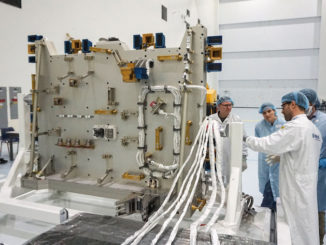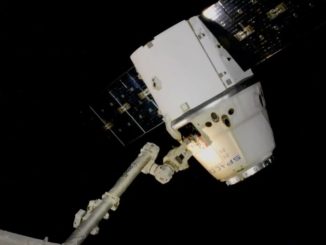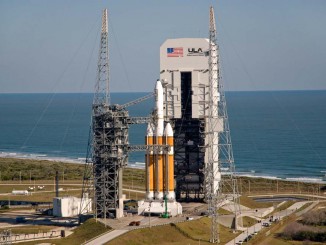EDITOR’S NOTE: Updated at 12 p.m. EST (1700 GMT) after departure, with updated information on nanosatellite deployments.
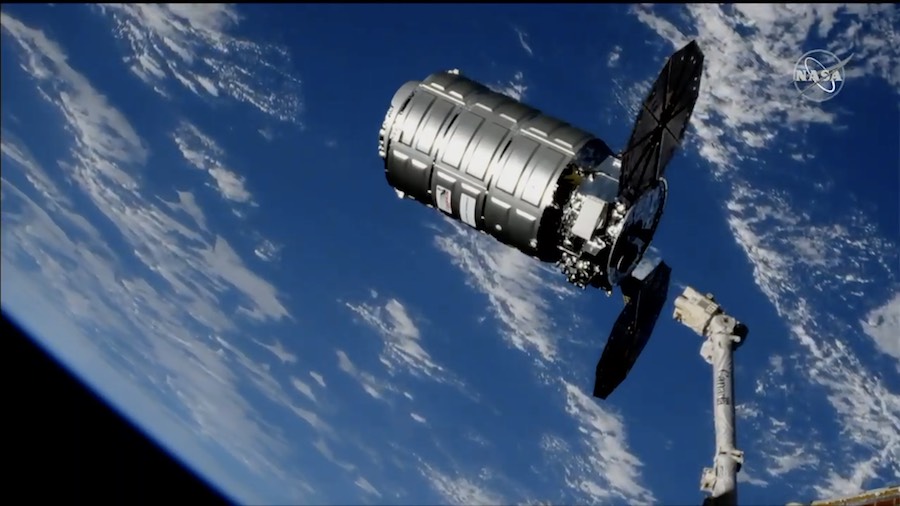
A commercial Cygnus supply ship departed the International Space Station on Friday for an extended mission to deploy five nanosatellites and conduct other experiments before re-entering the atmosphere and burning up with more than two tons of trash.
The space station’s nearly 58-foot-long (17-meter) robotic arm grappled the Cygnus spacecraft and pulled it away from a berthing port on the orbiting outpost’s Unity module early Friday, setting up for release of the supply ship at 11:16 a.m. EST (1616 GMT) under the command of Expedition 58 flight engineer Anne McClain.
The Cygnus spacecraft fired thrusters to depart the vicinity of the station, then was expected to raise its orbit to an altitude of around 300 miles (500 kilometers) for the separation of four tiny nanosatellites. The cargo ship will then lower its orbit below the station’s altitude to deploy another CubeSat before conducting a deorbit burn to fall back into the atmosphere for a destructive re-entry over the Pacific Ocean.
The Cygnus is wrapping up the 10th resupply mission, also known as NG-10, to the space station by Northrop Grumman Innovation Systems, formerly known as Orbital ATK, under an 11-launch contract with NASA. The cargo contract with NASA is valued at $2.89 billion, according to a report by the Government Accountability Office.
The cargo craft was christened S.S. John Young in honor of the late Gemini, Apollo and space shuttle astronaut. The ship is made up of a propulsion and service module made by Northrop Grumman in Dulles, Virginia, and a pressurized cargo cabin provided by Thales Alenia Space in Turin, Italy.
The S.S. John Young arrived at the space station Nov. 19, two days after launching aboard an Antares booster from Wallops Island, Virginia, delivering 7,215 pounds (3,273 kilograms) of experiments, hardware, spare parts, food and supplies for the station and its crew.
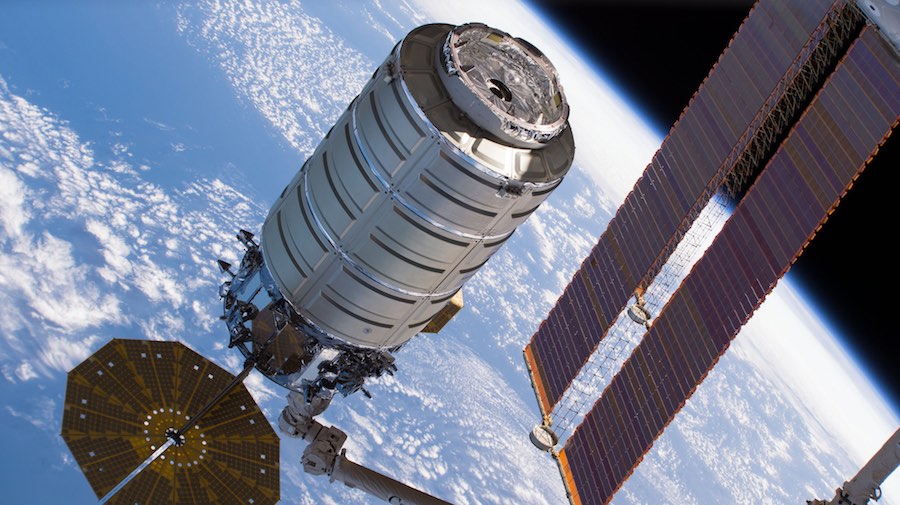
The payloads delivered to the station in November aboard Cygnus included a plastic recycler and 3D printer built to advance in-space manufacturing capabilities, and an experiment studying how the human body’s ability to perceive motion, orientation and distance changes in microgravity.
Astronauts replaced the fresh experiments and supplies with trash, packing around 5,500 pounds (2,500 kilograms) of garbage into the Cygnus cargo module for disposal during re-entry. The crew also installed a Slingshot nanosatellite deployer and an experimental payload on the forward hatch of the Cygnus spacecraft before Friday’s departure.
The experimental payload is for UbiquitiLink, a Virginia company planning to develop a nanosatellite communications network. The UbiquitiLink experiment aboard the Cygnus is expected to remain attached to the spacecraft.
The first two CubeSats to be released in orbit by Cygnus will be MYSat 1 and CHEFSat 2, set for deployment in a roughly 300-mile-high orbit around eight hours after the cargo craft leaves the space station.
MYSat 1 is a 1U CubeSat around the size of a Rubik’s cube. Carrying two payloads — camera and a lithion-ion coil cell battery — MYSat 1 was built by Masdar Institute of Science and Technology in Abu Dhabi with the support of Northrop Grumman Innovation Systems and Al Yah Satellite Communications Company in the United Arab Emirates.
CHEFSat 2 from the U.S. Naval Research Laboratory will also be deployed in the higher orbit.
About the size of a shoebox, CHEFSat 2 is a copy of a CubeSat launched on a Cygnus cargo mission to the space station last November. CHEFSat 2 will test commercial off-the-shelf technologies to evaluate their performance in space, focusing on new radio communications capabilities.
The Slingshot deployer will eject two more CubeSat missions — a pair of passive payloads named Quantum Radar 1 and 2, and ULTP 1, both developed by SEOPS, a Texas company that also provided the Slingshot mechanism. The Quantum Radar satellites are covered in optical reflectors, allowing students on the ground to use laser telescopes to track their orbits as atmospheric drag slows them down and lowers their altitude, before they eventually burn up during re-entry.
The ULTP 1 payload will demonstrate “two-way connectivity between small satellite communications payload technology and low-power devices on Earth,” according to a summary of the experiment provided by SEOPS to NASA. “This investigation aims to validate the use of this technology in space, and is intended to be deployed as a backbone for future commercial communication services.”
Cygnus will lower its orbit below the space station’s altitude after releasing MYSat 1, CHEFSat 2, Quantum Radar 1 and 2, and ULTP 1, targeting an altitude of around 200 miles (325 kilometers) for separation of KickSat 2, a NASA-sponsored CubeSat mission led by principal investigator Zac Manchester at Stanford University.
KickSat 2 carries 100 tiny “sprites” or “femtosatellites” — essentially 1.4-inch (3.5-centimeter) square circuit boards with integrated power, computing, sensing and communication equipment. The mission is a follow-up to the KickSat mission that launched in 2014, but failed to release its sprites in orbit.
The mission will test the limits of satellite miniaturization, a trend toward affordability widely popularized by the CubeSat design over the last two decades. But KickSat’s sprites are a tiny fraction of the size of a CubeSat.
KickSat 2 will eject its sprites at a lower altitude to ensure the circuit boards re-enter Earth’s atmosphere in a matter of weeks, avoiding the possibility of the sprites, which could be difficult to track with ground-based radars, becoming a long-term space debris threat to other satellites.
The deployment of the MYSat 1, CHEFSat 2 and KickSat 2 nanosatellites was arranged by NanoRacks. Those CubeSats were launched with the Cygnus spacecraft inside their externally-mounted deployers. The Slingshot mechanism launched inside a SpaceX Dragon cargo craft in December.
“NG-10 continues to highlight Northrop Grumman’s ability to meet the needs of multiple customers throughout one mission to the International Space Station,” said Frank DeMauro, vice president and general manager, space systems, Northrop Grumman. “During each trip to the station, Cygnus continues to demonstrate additional capabilities as we partner with new commercial customers. These new relationships will create opportunities for the International Space Station to expand its role as a unique platform for ground-breaking science.”
Re-entry of the Cygnus spacecraft over the Pacific Ocean is planned Feb. 25.
Northrop Grumman’s next Antares launch with a Cygnus supply ship to the International Space Station is scheduled April 17 from Virginia’s Eastern Shore.
Email the author.
Follow Stephen Clark on Twitter: @StephenClark1.

